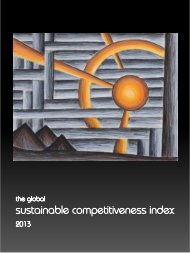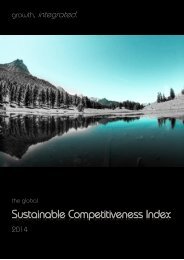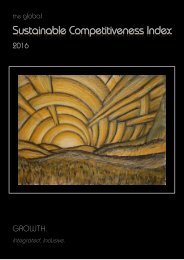The-Global-Sustainable-Competitiveness-Index-2015
Create successful ePaper yourself
Turn your PDF publications into a flip-book with our unique Google optimized e-Paper software.
Summary<br />
<strong>Sustainable</strong><br />
Competitive<br />
Natural<br />
Capital<br />
Resource<br />
Management<br />
Social<br />
Capital<br />
Intellectual<br />
Capital<br />
Governance<br />
Spotlight<br />
Data<br />
2 <strong>Sustainable</strong> <strong>Competitiveness</strong><br />
2.1 <strong>The</strong> <strong>Sustainable</strong> <strong>Competitiveness</strong> Model<br />
<strong>The</strong> three-dimensional sustainability model of reconciling the economy, the<br />
environment and the society is often used and applied in the corporate world to<br />
evaluate and manage sustainability issues and performance.<br />
However, corporations are entities that operate in very<br />
different boundaries and with different goals than<br />
states and nation-economies. <strong>The</strong> elements of the<br />
model therefore have to be adapted to the<br />
characteristics of nations and their fundament of<br />
sustained prosperity.<br />
While corporate or economic entities (depending on<br />
the nature of their business) are working with natural<br />
capital, they do not depend on the location of the<br />
capital (natural, human, financial) they utilize, and<br />
therefore can move their operations to where the<br />
external conditions are most favourable, both in terms<br />
of physical location (offices/factories) and markets, as<br />
well as in terms of business fields. Transport and<br />
international trade have made countries and people<br />
less dependent on their immediate environment<br />
through international trade of resources, including<br />
water. However, countries and population cannot simply move should<br />
fundamental resources (water, agricultural output) become scarce or the<br />
country inhabitable due to climate change. At the end of the day people rely<br />
on, and life off, the natural capital of their environment for better or worse.<br />
Model of sustainable<br />
development often<br />
applied in ESG research<br />
<strong>The</strong> <strong>Sustainable</strong> <strong>Competitiveness</strong> Pyramid<br />
<strong>Sustainable</strong> competitiveness - they ability to<br />
generate and sustain inclusive wealth and<br />
dignifying standard of life for all citizens in a<br />
globalised world of competing economies,<br />
consists of 5 key elements that interact and<br />
influence each other: natural capital (the<br />
given natural environment and climate, minus<br />
human induced degradation and pollution),<br />
social capital, intellectual capital (the ability<br />
to compete in a globalised market through<br />
sustained innovation), resource management<br />
(the ability to extract the highest possible<br />
value from existing resources (natural, human,<br />
financial), and governance (the framework given, normally by government<br />
policies & investments, in which a national economy operates).<br />
<strong>The</strong> <strong>Sustainable</strong><br />
<strong>Competitiveness</strong><br />
Pyramid<br />
the sustainable competitiveness index <strong>2015</strong><br />
page 15








